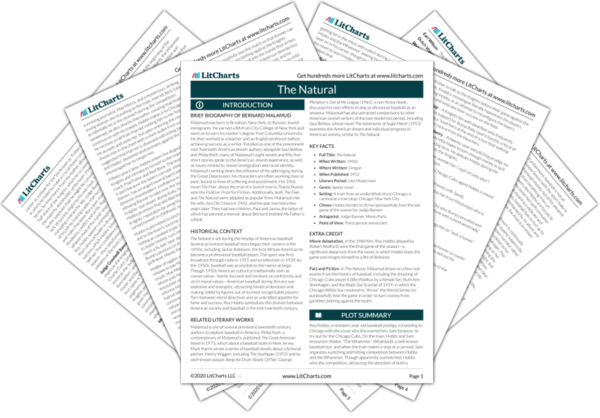Brief Biography of Bernard Malamud
Malamud was born in Brooklyn, New York, to Russian Jewish immigrants. He earned a BA from City College of New York and went on to earn his master’s degree from Columbia University. He then worked as a teacher and an English professor before achieving success as a writer. Extolled as one of the preeminent mid-Twentieth AmericanJewish authors alongside Saul Bellow and Philip Roth, many of Malamud’s eight novels and fifty-five short stories speak to the American Jewish experience, as well as issues related to Jewish immigration and racial identity. Malamud’s writing bears the influence of his upbringing during the Great Depression: his characters are often working class or poor, bound to lives of suffering and punishment. His 1966 novel The Fixer, about the trial of a Jewish man in Tsarist Russia, won the Pulitzer Prize for Fiction. Additionally, both The Fixer and The Natural were adapted as popular films. Malamud met his wife, Ann De Chiara in 1942, and the pair married a few years later. They had two children, Paul and Janna, the latter of which has penned a memoir about Bernard entitled My Father is a Book.
Historical Context of The Natural
The Natural is set during the heyday of American baseball. Several prominent baseball stars began their careers in the 1950s, including Jackie Robinson, the first African American to become a professional baseball player. The sport was first broadcast through radio in 1921 and on television in 1939; by the 1950s, baseball was accessible to the nation at large. Though 1950s American culture is traditionally seen as conservative—family-focused and insistent on conformity and strict moral values—American baseball during this era was explosive and energetic, attracting fanatical devotees and making celebrity figures out of its most recognizable players. Torn between moral directives and an unbridled appetite for fame and success, Roy Hobbs symbolizes this division between American society and baseball in the mid-twentieth century.
Other Books Related to The Natural
Malamud is one of several prominent twentieth-century authors to explore baseball in America. Philip Roth, a contemporary of Malamud’s, published The Great American Novel in 1973, which about a baseball team in New Jersey. Mark Harris wrote a series of baseball novels about a fictional pitcher, Henry Wiggen, including The Southpaw (1953) and its well-known sequel, Bang the Drum Slowly (1956). George Plimpton’s Out of My League (1961), a non-fiction book, discusses his own efforts to play professional baseball as an amateur. Malamud has also attracted comparisons to other American Jewish writers of the late modernist period, including Saul Bellow, whose novel The Adventures of Augie March (1953) examines the American dream and individual progress in American society, similar to The Natural.
Key Facts about The Natural
-
Full Title: The Natural
-
When Written: 1950s
-
Where Written: Oregon
-
When Published: 1952
-
Literary Period: Late Modernism
-
Genre: Sports novel
-
Setting: A train from an unidentified city to Chicago; a carnival at a train stop; Chicago; New York City
-
Climax: Hobbs decides to throw (purposefully lose) the last game of the season for Judge Banner.
-
Antagonist: Judge Banner, Memo Paris
-
Point of View: Third-person omniscient
Extra Credit for The Natural








